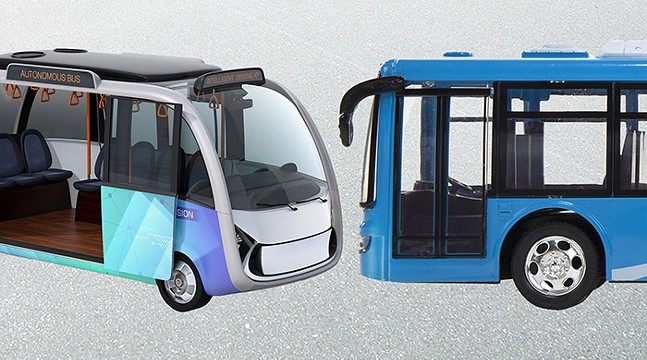For the last few years, Pittsburgh city officials have been met with significant pushback on their proposal to run autonomous shuttles from Oakland to Hazelwood. The proposal is called the Mon-Oakland Connector, and the goal is to run driverless shuttles from central Oakland, through the Junction Hollow trail in Schenley Park, and onto Hazelwood.
Proponents believe the project can increase mobility between Oakland, a bustling job center, and the emerging job centers at the Pittsburgh Technology Center in South Oakland, near the Monongahela River, and Hazelwood Green, a new development meant to attract tech companies.
In theory, increasing transit and mobility between these locations would be a boost for the city, but transit advocates have been skeptical the proposal can accomplish its goals.
And a new report commissioned by Pittsburghers for Public Transit only adds to that skepticism. The report titled “A People’s Audit of the Mon-Oakland Connector” concludes that minor improvements to Port Authority bus schedules and routing “would outperform even the best-case scenario for the Mon-Oakland shuttle roadway, and would better connect institutions and residents within the corridor,” according to a press release.
If completed, the Mon-Oakland Connector will utilize slow-moving autonomous shuttles that will move along a 5-mile loop from Oakland to Hazelwood, complete with about a dozen stations. Similar shuttles used in projects like Las Vegas and Arlington, Texas travel an average of 15 mph and can hold about 12 people.
The city anticipates to spend $23 million on the Mon-Oakland Connector, and sources say private foundations have promised to add millions more. PPT has proposed that money be spent instead on helping to improve bus service like adding weekend service to the 93 bus and extending the 75 bus to travel through Hazelwood Green.
The report was completed by Tech4Society, a group of Carnegie Mellon University students looking to put their tech skills for social good and to service local activist organizations. It says that a hypothetical shuttle traveling on the Mon-Oakland Connector route would take about 22 minutes from the Irvine Street and Hazelwood Avenue stop to either the University of Pittsburgh stop on Forbes Avenue and Bigelow Boulevard, or the Carnegie Mellon University stop on Neville Street below Forbes Avenue. When the shuttle continues on to other popular destinations, the times get longer. From the Irvine Street and Hazelwood Avenue stop to UPMC Montefiore would take 32 minutes, and to UPMC Presbyterian would take 34 minutes.
By comparison, the report notes that if the 75 bus were extended along a new route, it would take 26 minutes to get to the Pitt stop from Hazelwood, and 36 minutes to get to CMU, thanks to a 10 minute walk from Craig Street. But it would take only 21 minutes to get to UPMC Montefiore, and 23 minutes to get to UPMC Presbyterian.
Additionally, this new 75 route would also pass through the South Side and have the opportunity to pick up many students who live in the neighborhood. Port Authority buses also have far greater capacity than the proposed autonomous shuttles and can hold many times more riders at a time.
The report concludes that extending the 75 bus would cost Port Authority about $1.1 million a year. (About $23 million has been promised to the Mon-Oakland Connector over several years from the city, with private foundations likely contributing millions more.)
“In running a comparison, taking into account transfer and walking times, it is hard to see significant benefit to the shuttle over existing transit options,” notes the report. “With the proposed extension of the 75, shown farther below in the report, the travel time savings becomes even more significant.”
Pittsburgh Mayor Bill Peduto’s spokesperson Tim McNulty refutes the study, and says that increased traffic shouldn’t be added to Bates Street.
"This is an initiative to connect Hazelwood to the third-largest economic center in Pennsylvania, using electric vehicles to take increased vehicular traffic off Second Avenue and Bates Street,” says McNulty in a statement. “The existing connection to Oakland using Bates is not sufficient and cannot handle increased traffic, so the City and its partners are working on an environmentally beneficial plan to connect workers to jobs."
However, the proposals outlined in the report don’t suggest that bus service be added to Bates Street, as the 75 extension would travel over the Birmingham Bridge, weekend service for the 93 would utilize its current route through Schenley Drive, and a proposed Second Avenue Bus Rapid Transit extension would follow a route along the Mon River.
The report notes that adding weekend service to the 93 would give more access to Hazelwood residents to shop at grocery stores in Greenfield or Squirrel Hill, and a Second Avenue BRT would increase job access to Downtown. It notes these additions would be more broadly beneficial than the Mon-Oakland Connector, which it says would primarily benefit CMU by shortening its commute to Hazelwood by 13 minutes.
“We wanted to answer questions the public has raised regarding the cost to build and operate the project, ridership capacity and projected need, and anticipated travel time between key destinations like hospitals and the universities,” said Tech4Society researcher Bonnie Fan in a press release. “In all categories, the Mon-Oakland Connector fails in comparison to public transit improvements.”


